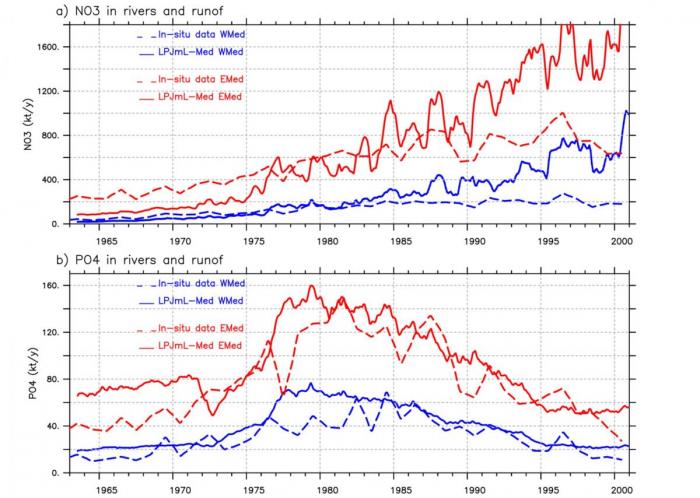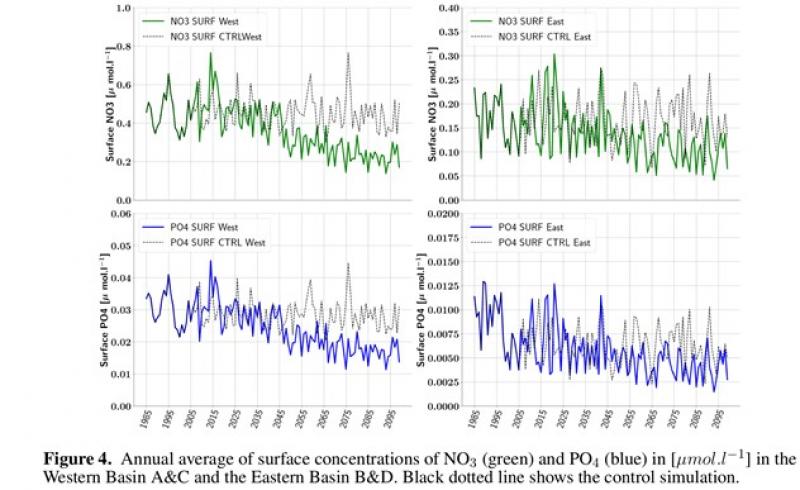OT-Med PhD students: Rémi Page (sub-project OCEAN), Simon Decock (sub-project LAND)
OT-Med post-doctoral fellows: Anne-Sophie Augueres (OT-Med post-doc, sub-project LAND), Leonith Hinojosa Valencia (sub-project ECONOMICS), Mohamed Ayache (sub-project LAND & integrated model)
OT-Med engineers: Nicolas Barrier (data base), Pierre Mouginot (sub-project LAND), Ivana Mardesic (sub-project ECONOMICS)
Melika Baklouti, François Carlotti, Léo Berline, Jean-Michel André (MIO)
Alberte Bondeau, Wolfgang Cramer (IMBE)
Dominique Ami (GREQAM / AMSE)
Pierre Batteau (CERGAM)
Claude Napolénone (INRA Avignon)
Joël Guiot (CEREGE)
The LASERMED project aims at predicting the impacts of climate change on terrestrial and marine ecosystems of the Mediterranean Basin, and on the services they provide in terms of agricultural production, terrestrial and marine carbon sequestration, and fisheries. The project is organized in 3 main sub-projects.
Sub-project ECONOMICS: elaborating consistent socio-economic regional scenarios to reach food sufficiency for the Mediterranean basin population in a context of climate change and population increase. Each generated scenario induces a specific land use change, from the current land use structure, as well as particular agricultural practices with effects on carbon sequestration
Sub-project LAND: modelling the biogeochemical functioning of Mediterranean agro-ecosystems for assessment of their ecosystem services. Assessment of sustainability criteria for the future of Mediterranean agriculture under global change scenarios. This sub-project objectives are:
- adding nitrogen and phosphorus transfer in LPJmL model (an existing generic large-scale agro-ecosystems model), to account for the processes occurring at the agro-ecosystem level (N-fixation, fertilization, atmospheric deposition) and the net food and feed imports
- adapting LPJmL that already simulates the coupled carbon and water cycle of several potential natural and cultivated/managed plant functional types, with additional permanent cropping systems (olive-trees, vineyards, orchards)
- performing spatial simulations with the model around the Mediterranean to estimate several ecosystem services directly depending on the management of agro-ecosystems.
Sub-project OCEAN : Impact of climate change and land-use on carbon sequestration and productivity of marine ecosystems of the Mediterranean Sea. The objectives are :
- to define relevant environmental indicators that characterize the biogeochemical functioning of the Mediterranean and/or link some biogeochemical features of the Mediterranean to key ecosystem services.
- to use these indicators to compare two simulations/scenarios and to assess the effects of climate change on key ecosystem services.
- to investigate the effect of climate change (including rive inputs changes in terms of nutrients and organic matter) on the Mediterranean marine ecosystem.
ECONOMICS
- Designed 3 different land-use/land-management scenarios which take into account the ecological impact of agriculture. Scenarios aim to achieve some predetermined levels of food sufficiency for Mediterranean populations following the increase of the food demand by 2050.
- Designed extensive databases to cover the Mediterranean region to fit and test empirical models of food production. Content includes for instance production for 42 crops in the base-year 2005, land cover and population at a scale of 10x10 km².
- Identified the main drivers of food production by means of spatial econometrics models which allow for assessing spatial heterogeneity and the multi-level effects: population indicators, land use/land management indicators and climatic variables.
LAND
1) Land-sea coupling: implementation in the LPJmL model of nutrient (N and P) transfers from land and urban areas to the rivers, and then to the Mediterranean sea.
- Representations in the model of nutrient transformation and retention processes (residue decomposition, nitrification, adsorption and denitrification), river transport and phytoplankton dynamics.
- The input data for the hindcast simulation over 1960-2012 have been prepared: climate, soil classes, river routing, land use, fertilizers, manure, nutrient content of wastewater. They cover the entire catchments of rivers flowing towards the Mediterranean sea.
- The first basin-wide LPJmL simulation at 1/12° indicates that the model succeeds in simulating the interannual variability of water discharge for the main rivers especially the Po, Rhone and Ebro Rivers, as well as good adequation between simulated and in-situ nutrients concentration (NO3 and PO4).
- NO3 showed a more or less continuous increase from the early 1960s until the present in all three rivers, while there is a strong increase in PO4 fluxes between 1960 and 1980, followed by a decrease from the second half of the 1980s as a consequence of the banning of phosphates in detergents, and the construction of waste water treatment plants. Wastewater strongly contributes to the phosphate fluxes, while both agriculture and wastewater control the nitrogen (mainly as NO3) fluxes.
2) Preparation of the input data for the RCP 8.5 scenario, coupling with the economic model
- Delivery of a land use data set by the economic model that simulates the cover fractions of the 52 LPJmL-Med crop functional types for the year 2050.
- Interpolation of the annual land use input for the 2005-2100 scenario run. Projections of GDP, urban and rural population are also used to generate annual input data of nutrient forcing (fertilizers, manure, nutrient content of wastewater) until 2020.
N-NO3 (a) and P-PO4 (b) inputs from rivers and runoff in kt.y-1 for the western basin in blue and for the eastern basin in red from the LPJmL-Med outputs (plain line) and from Ludwig et al. (2009) data (dotted line). Figure 11 of Ayache et al. (subm.)
OCEAN
1) Conclusions from model output:
- 60% diminution of phosphate (PO4) in river inputs into the Mediterranean Sea since the end of the 1980s induced a significant lowering of PO4 availability in the sub-surface layer of the Eastern Mediterranean Basin (EMB)
- 20% average rise - never previously documented - of dissolved organic carbon (DOC) concentrations in the surface layer
- New explanation for occurrence of gradual deepening of the top of the phosphacline that generates a shift between the top of the nitracline and the top of the phosphacline in the EMB (documented in other studies)
- Evidence of the decline in abundance and the reduction of size of copepods over 1985–2010, that could partially explain the reduction in size of anchovy and sardine recently recorded in the Mediterranean Sea
- First evidence that variations in river inputs that occurred in the last decades may have significantly altered the biogeochemical cycles of two key elements (P and N), in particular in the EMB.
2) Run of the first RCP 8.5 scenario for the marine model suggest that
- Changes in the biogeochemistry of the MS will occur (under the RCP 8.5 scenario) after 2050.
- The MS will become increasingly oligotrophic, and therefore less and less productive (14 % decrease in integrated primary production in the Western Basin and in the Eastern Basin).
- Significant changes may occur in the planktonic food web, with a reduction (22 % in the Western Basin and 38 % in the Eastern Basin) of large phytoplankton species abundance in favour of small organisms.
- Organisms should be more and more N-limited in the future since NO3 concentrations are expected to decline more than those of PO4 in the surface layer.
- These changes are expected to occur mainly in the Western Basin, while the Eastern Basin is expected to be less impacted.
Mainstream article / Article tout public (La Marseillaise, 22/02/2020): Et si l'eau des fleuves faisait rétrécir les sardines en Méditerranée?
EGU 2020 presentation by Mohamed Ayache: A new estimation of water and nutrients (N & P) discharge to the Mediterranean Sea from the LPJmL model: modelling the dynamics of the land-sea nutrient transfer




